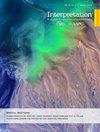机器学习应用于评估印度近海海洋沉积物中甲烷水合物的赋存率和饱和度
IF 1
4区 地球科学
Q3 GEOCHEMISTRY & GEOPHYSICS
Interpretation-A Journal of Subsurface Characterization
Pub Date : 2023-10-04
DOI:10.1190/int-2023-0056.1
引用次数: 0
摘要
利用人工神经网络(ANN)对印度近海海洋沉积物中甲烷水合物赋存状态和饱和度进行了评价。人工神经网络分析将天然气水合物赋存状态分为孔隙空间甲烷水合物、裂缝甲烷水合物和无甲烷水合物三种类型。此外,预测的饱和度表征了天然气水合物相对于可用空隙体积的体积。在印度国家天然气水合物计划远征02 (NGHP-02)期间,从6口井中收集的测井数据提供了测井测量数据的组合,这些数据被用作机器学习(ML)模型的输入。测井测量包括密度、孔隙度、电阻率、自然伽马辐射和声波速度。ML模型中使用的测井曲线组合在预测天然气水合物产状方面提供了良好的总体平衡精度(0.79 ~ 0.86),在预测海洋聚集的甲烷水合物饱和度方面提供了良好的精度(0.68 ~ 0.92)。精度评分表明,ML模型能够较好地预测海相甲烷水合物储层特征。结果表明,ML模型既可以增强物理驱动的方法来评估甲烷水合物矿床的产状和饱和度,也可以作为这些特征的独立预测工具。本文章由计算机程序翻译,如有差异,请以英文原文为准。
Machine Learning Application to Assess Occurrence and Saturations of Methane Hydrate in Marine Deposits Offshore India
Artificial Neural Networks (ANN) were used to assess methane hydrate occurrence and saturation in marine sediments offshore India. The ANN analysis classifies the gas hydrate occurrence into three types: methane hydrate in pore space, methane hydrate in fractures, or no methane hydrate. Further, predicted saturation characterizes the volume of gas hydrate with respect to the available void volume. Log data collected at six wells, which were drilled during the India National Gas Hydrate Program Expedition 02 (NGHP-02), provided a combination of well log measurements that were used as input for machine learning (ML) models. Well log measurements included density, porosity, electrical resistivity, natural gamma radiation, and acoustic wave velocity. Combinations of well logs used in the ML models provide good overall balanced accuracy (0.79 to 0.86) for the prediction of the gas hydrate occurrence and good accuracy (0.68 to 0.92) for methane hydrate saturation prediction in the marine accumulations against reference data. The accuracy scores indicate that the ML models can successfully predict reservoir characteristics for marine methane hydrate deposits. The results indicate that the ML models can either augment physics-driven methods for assessing the occurrence and saturation of methane hydrate deposits or serve as an independent predictive tool for those characteristics.
求助全文
通过发布文献求助,成功后即可免费获取论文全文。
去求助
来源期刊

Interpretation-A Journal of Subsurface Characterization
GEOCHEMISTRY & GEOPHYSICS-
CiteScore
2.50
自引率
8.30%
发文量
126
期刊介绍:
***Jointly published by the American Association of Petroleum Geologists (AAPG) and the Society of Exploration Geophysicists (SEG)***
Interpretation is a new, peer-reviewed journal for advancing the practice of subsurface interpretation.
 求助内容:
求助内容: 应助结果提醒方式:
应助结果提醒方式:


